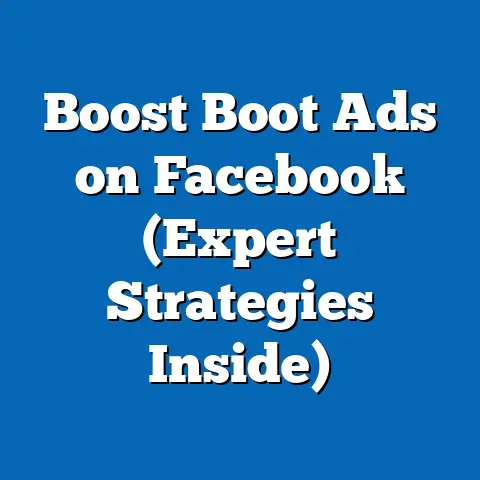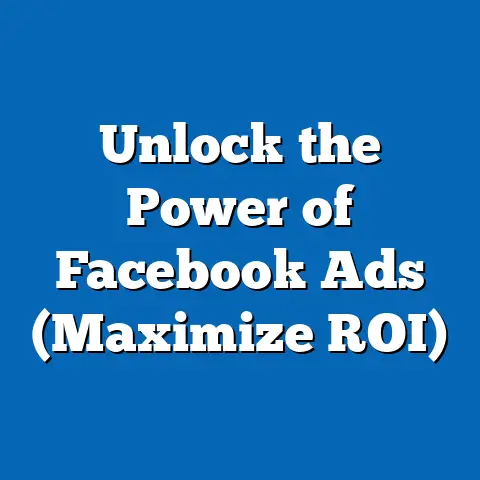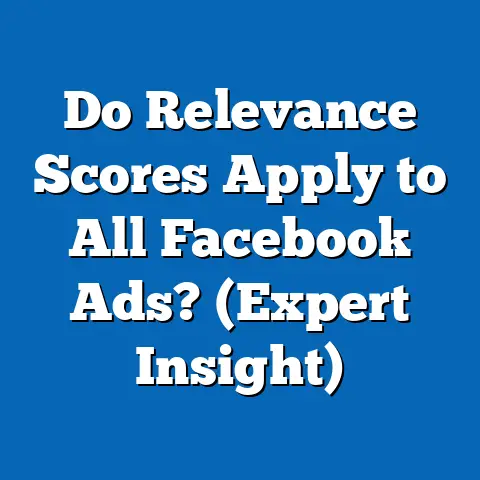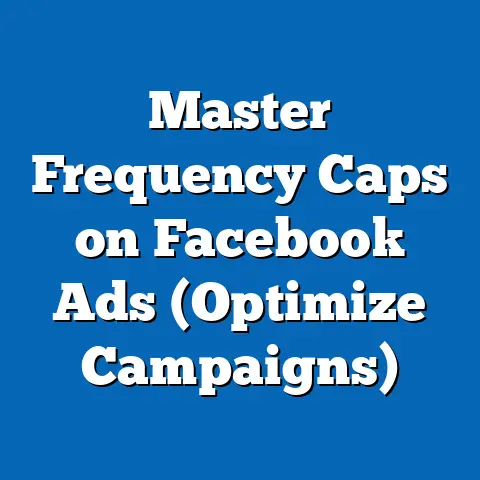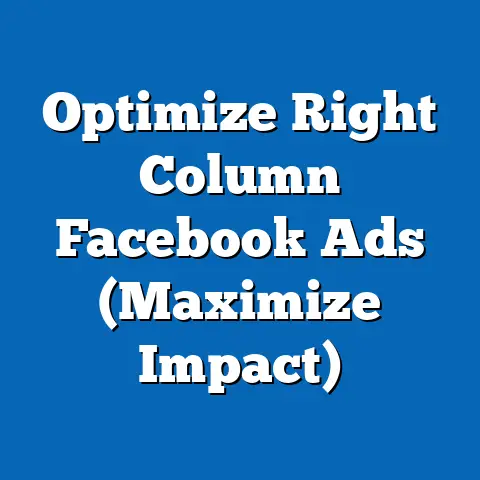Mastering Facebook Ad Ratios (Essential Guide for Success)
Facebook advertising remains a cornerstone of digital marketing, with businesses worldwide leveraging the platform to reach targeted audiences. In 2023, Facebook (now under Meta) reported over 2.9 billion monthly active users, making it one of the largest advertising platforms globally, according to Statista. Ad spend on the platform continues to grow, with eMarketer estimating that global ad revenue for Meta reached $114.9 billion in 2022, a figure projected to climb to $130.3 billion by 2024.
Understanding and mastering ad ratios—key metrics such as Click-Through Rate (CTR), Cost Per Click (CPC), Conversion Rate, and Return on Ad Spend (ROAS)—is critical for optimizing campaigns. Research from WordStream indicates that the average CTR for Facebook ads across industries is 0.90%, while the average CPC stands at $1.72. However, these figures vary widely by demographic, industry, and geographic location, necessitating a nuanced approach to campaign design.
The Innovation Behind Facebook Advertising
Evolution of a Digital Giant
Facebook’s advertising platform has undergone significant innovation since its inception in 2007, when it first introduced “Flyers” as a rudimentary ad format. The launch of the self-service ad platform in 2012 marked a turning point, enabling businesses of all sizes to create targeted campaigns using detailed user data. Today, innovations like machine learning-driven ad optimization, dynamic creative ads, and augmented reality (AR) experiences have transformed how brands engage with audiences.
According to a 2022 report by Hootsuite, 78% of marketers now use Facebook’s advanced targeting options, such as lookalike audiences and interest-based segmentation, to improve ad relevance. This shift reflects a broader trend toward personalization, driven by Meta’s investment in AI algorithms that predict user behavior. These technological advancements have directly impacted ad ratios, with better targeting often leading to higher CTRs and lower CPCs.
Statistical Trends in Ad Performance
Ad performance on Facebook is measured through key ratios that indicate campaign effectiveness. As of 2023, WordStream data shows the average CTR for Facebook ads at 0.90%, a slight decline from 1.11% in 2019, reflecting increased competition and ad fatigue among users. Meanwhile, the average CPC has risen from $1.01 in 2018 to $1.72 in 2023, a 70% increase, driven by higher demand for ad inventory and inflation in digital ad costs.
Conversion rates, which measure the percentage of users who complete a desired action after clicking an ad, average 9.21% across industries, per WordStream’s 2023 benchmarks. However, ROAS—a critical metric for assessing profitability—varies significantly, with eMarketer reporting an average of 6.5x for e-commerce brands but only 2.3x for B2B sectors. These disparities highlight the importance of tailoring ad strategies to specific goals and industries.
Demographic Breakdowns of Ad Performance Ratios
Age and Gender Variations
Demographic factors play a significant role in shaping Facebook ad ratios. According to a 2023 Statista survey, users aged 25-34 represent the largest demographic on the platform, accounting for 29.6% of global users, followed by the 18-24 age group at 23.1%. Ads targeting younger users (18-24) often achieve higher CTRs—averaging 1.2%—due to their higher engagement with visual and interactive content, as noted in a Sprout Social report.
Gender differences also influence performance metrics. Women tend to exhibit a slightly higher CTR (0.95%) compared to men (0.85%), per WordStream data, possibly due to differences in content preferences and platform usage patterns. Marketers targeting female audiences often see better results with lifestyle and e-commerce ads, while male audiences respond more to tech and gaming promotions.
Geographic and Income-Based Disparities
Geographic targeting reveals stark contrasts in ad costs and effectiveness. In North America, where disposable income is higher, the average CPC is $2.15, significantly above the global average of $1.72, according to eMarketer. In contrast, emerging markets like India report CPCs as low as $0.25, reflecting lower competition and ad spend but also reduced purchasing power.
Income levels further impact conversion rates and ROAS. A 2022 study by Nielsen found that users in high-income brackets (above $75,000 annually) are 30% more likely to convert on premium product ads compared to those in lower-income brackets (below $30,000). This underscores the need for marketers to align ad creative and offers with audience affordability.
Industry-Specific Performance
Ad ratios also vary widely by industry, reflecting differing consumer behaviors. WordStream’s 2023 data highlights that the fitness industry boasts the highest average CTR at 1.49%, driven by visually compelling content and seasonal trends like New Year’s resolutions. Conversely, the technology sector lags with a CTR of 0.56%, as tech ads often target niche, less impulse-driven audiences.
E-commerce leads in conversion rates, averaging 10.11%, while legal services struggle at 5.31%, likely due to higher decision-making barriers. Understanding these industry benchmarks is crucial for setting realistic expectations and optimizing ad ratios through tailored messaging and creative strategies.
Historical Comparisons: How Ad Ratios Have Evolved
Shifts in Key Metrics Over Time
Comparing current ad ratios with historical data reveals significant shifts driven by platform changes and market dynamics. In 2015, the average CTR for Facebook ads was 1.55%, nearly double the 2023 figure of 0.90%, according to a historical analysis by AdEspresso. This decline can be attributed to increased ad saturation—Meta reported a 40% rise in ad impressions from 2015 to 2022—as well as evolving user behaviors favoring organic content over ads.
CPC trends tell a different story. In 2015, the average CPC was just $0.64, per AdEspresso, compared to $1.72 in 2023, a 169% increase. This surge reflects growing competition for ad space, particularly as small and medium-sized businesses (SMBs) entered the market following the accessibility of self-service tools post-2012.
Impact of Algorithm Changes and Privacy Policies
Historical shifts in ad ratios are also tied to Meta’s algorithm updates and privacy regulations. The 2018 Cambridge Analytica scandal prompted stricter data usage policies, reducing targeting precision and contributing to a 10-15% drop in CTRs that year, per eMarketer. Similarly, Apple’s 2021 iOS 14.5 update, which introduced App Tracking Transparency (ATT), led to a reported 20% increase in CPCs as advertisers struggled with limited tracking data, according to a Forbes analysis.
These changes highlight the importance of adapting to external factors. Marketers who pivoted to contextual targeting and first-party data strategies saw less disruption, with some reporting ROAS improvements of up to 25% by focusing on in-platform engagement metrics, as noted in a 2022 Hootsuite report.
Detailed Analysis of Key Ad Ratios
Click-Through Rate (CTR): Measuring Engagement
CTR, defined as the percentage of users who click on an ad after seeing it, is a primary indicator of ad relevance and creative appeal. The 2023 industry average of 0.90% masks significant variation—top-performing ads in competitive niches can achieve CTRs as high as 3%, per WordStream. Factors driving higher CTRs include compelling visuals (e.g., video ads, which have a 20% higher CTR than static images) and precise audience targeting.
To improve CTR, marketers should test multiple ad formats and monitor relevance scores provided by Meta’s Ads Manager. A relevance score above 7 (on a 1-10 scale) typically correlates with a 15-20% higher CTR, based on historical data from AdEspresso. Regular A/B testing of headlines and images can further refine performance.
Cost Per Click (CPC): Balancing Cost and Reach
CPC measures the average cost incurred for each click on an ad, directly impacting campaign budgets. The 2023 global average of $1.72 reflects a competitive landscape, with costs peaking during high-demand periods like the holiday season, where CPCs can rise by 30-50%, per eMarketer. Strategies to lower CPC include optimizing for off-peak times and targeting less saturated demographics, such as older users (55+), where CPCs average $1.10.
Geographic targeting also plays a role—marketers can reduce costs by focusing on tier-2 and tier-3 markets with lower competition. However, this must be balanced against conversion potential, as lower CPCs often correlate with reduced purchasing intent in less affluent regions.
Conversion Rate: Turning Clicks into Actions
Conversion rate tracks the percentage of users who take a desired action—such as making a purchase or signing up for a newsletter—after clicking an ad. The 2023 average of 9.21% varies by objective, with lead generation campaigns often achieving 12-15% conversion rates, while e-commerce hovers around 8-10%, per WordStream. Optimizing landing pages for mobile users, who account for 98.5% of Facebook traffic per Statista, can boost conversions by up to 20%.
Post-click experience is critical—slow load times or unclear calls-to-action (CTAs) can reduce conversion rates by 30%, according to Google’s mobile optimization studies. Marketers should prioritize user experience alongside ad creative to maximize this ratio.
Return on Ad Spend (ROAS): Measuring Profitability
ROAS, calculated as revenue generated per dollar spent on ads, is the ultimate measure of campaign success. The 2023 average ROAS of 6.5x for e-commerce reflects strong potential, though B2B sectors often see lower returns (2-3x) due to longer sales cycles, per eMarketer. High-performing campaigns often leverage retargeting, which can increase ROAS by 40% by focusing on users who have already shown interest.
To improve ROAS, marketers should focus on high-intent audiences and use dynamic product ads to showcase relevant items. Additionally, tracking lifetime customer value (LTV) alongside immediate returns provides a more holistic view of profitability, especially for subscription-based businesses.
Contextual Factors Influencing Ad Ratios
Economic and Seasonal Trends
Economic conditions significantly impact ad performance. During economic downturns, such as the 2020 COVID-19 crisis, CPCs dropped by 15% as businesses scaled back spending, per eMarketer. Conversely, inflationary pressures in 2022-2023 have driven up costs, with advertisers reporting a 10-20% increase in ad budgets to maintain reach.
Seasonality also plays a role—Q4 holiday campaigns see heightened competition, with CTRs often dropping by 10% due to ad fatigue, while CPCs spike. Marketers can mitigate this by starting campaigns early and using storytelling ads to stand out, a tactic shown to improve engagement by 25% during peak seasons, per a 2022 Nielsen study.
Platform Policies and User Behavior
Meta’s evolving policies, such as limits on ad frequency and content restrictions, influence ratios. Ads shown more than 3-4 times to the same user often see a 40% drop in CTR due to annoyance, per AdEspresso. Additionally, user behavior shifts—such as the growing preference for Stories over News Feed content—require format adjustments, with Stories ads achieving 15% higher CTRs in 2023, per Hootsuite.
Privacy concerns continue to shape performance. Post-iOS 14.5, 62% of users opted out of tracking, per Forbes, forcing marketers to rely on aggregated data and in-platform analytics. Adapting to these constraints is essential for maintaining effective ratios.
Visual Data Reference: Key Metrics at a Glance
To illustrate the trends discussed, consider the following summarized data (suitable for a chart or infographic):
- CTR by Industry (2023, WordStream): Fitness (1.49%), E-commerce (1.01%), Technology (0.56%)
- CPC by Region (2023, eMarketer): North America ($2.15), Europe ($1.50), Asia-Pacific ($0.80)
- Historical CPC Trend (2015-2023, AdEspresso): 2015 ($0.64), 2018 ($1.01), 2023 ($1.72)
- Conversion Rate by Objective (2023, WordStream): Lead Gen (12.5%), E-commerce (9.8%), App Install (7.2%)
These visuals can help marketers benchmark their performance and identify areas for optimization.
Future Projections: What Lies Ahead for Facebook Ad Ratios
Anticipated Growth in Ad Spend
Looking ahead, eMarketer projects that Meta’s ad revenue will reach $130.3 billion by 2024, a 13.4% increase from 2022. This growth will likely intensify competition, pushing CPCs higher—potentially to $2.00 globally by 2025. However, innovations in AI-driven targeting and creative automation may offset cost increases by improving ad relevance and CTRs.
Emerging markets will drive much of this growth, with user bases in Asia-Pacific and Africa expected to grow by 8-10% annually through 2027, per Statista. Marketers targeting these regions could see lower CPCs initially, though conversion rates may lag until digital literacy and purchasing power improve.
Impact of Emerging Technologies
The integration of AR and virtual reality (VR) into ads—part of Meta’s metaverse vision—could redefine engagement metrics. Early tests of AR ads show a 30% higher CTR compared to traditional formats, per a 2022 Meta case study. As these technologies become mainstream, expect a shift toward immersive experiences that prioritize user interaction over traditional clicks.
Additionally, advancements in privacy-compliant targeting, such as federated learning and on-device processing, may stabilize ad ratios post-ATT. Meta’s 2023 announcements suggest a 15-20% improvement in ad attribution accuracy by 2025, potentially restoring ROAS levels closer to pre-2021 benchmarks.
Strategic Implications for Marketers
Marketers must prepare for a dynamic landscape by investing in first-party data collection and diversifying ad formats. Focusing on video and Stories content, which are projected to account for 60% of ad impressions by 2025 per Hootsuite, will be critical for maintaining CTRs. Additionally, building long-term customer relationships through retargeting and loyalty campaigns can enhance ROAS amidst rising costs.
Experimentation will remain key—allocating 10-15% of budgets to testing new features like AR ads or cross-platform integrations with Instagram and WhatsApp can yield early-mover advantages. Staying agile in response to policy shifts and user trends will separate successful campaigns from underperforming ones.
Conclusion
Mastering Facebook ad ratios requires a deep understanding of metrics like CTR, CPC, conversion rate, and ROAS, alongside a strategic approach to demographic targeting and creative optimization. Statistical trends show a competitive landscape—CTRs have declined from 1.55% in 2015 to 0.90% in 2023, while CPCs have surged by 169% over the same period—reflecting increased ad saturation and evolving user behaviors. Demographic and industry variations further complicate performance, with younger users, women, and fitness ads often outperforming broader averages.
Historical analysis reveals the impact of algorithm changes and privacy policies, while contextual factors like economic conditions and seasonality continue to shape outcomes. Looking forward, projected ad revenue growth to $130.3 billion by 2024 and innovations in AR and AI suggest both challenges and opportunities for marketers.
By leveraging data-driven insights, testing innovative formats, and adapting to platform shifts, businesses can optimize their Facebook ad ratios for sustained success. This essential guide serves as a roadmap for navigating the complexities of one of digital marketing’s most powerful tools, empowering marketers to achieve measurable results in an ever-evolving ecosystem.


